Coming off my high of getting to spend a day at the Minnesota History Center Gale Family Library, I thought I’d share some tips for visiting this and other research facilities. A lot of these tips may be intuitive, but they can serve as a good reminder, and I will admit that I didn’t remember all of these before I took my recent trip to the library.
Prepare! Prepare! Prepare!
Before you make the trip, invest time in learning all you can about the facility and plan ahead so that you can use your on-site time most efficiently.
Are there restrictions?
What does your library let you bring into the research rooms? Visit their web page to find out.
- You probably will only be allowed to use pencils, NO PENS, so bring a couple sharpened pencils with you.
- You likely will not be able to bring your coat, purse, bag, backpack or other luggage into the rooms.
- So find out if they have lockers to rent.
- And bring your notes and to-do lists in a format that is allowed. Think loose leaf paper or notebooks rather than a large portfolio case.
- Do they allow cell phones, tablets and laptops? Chances are that the facility will allow these, and WIFI may even be available. But check before you go if you plan to bring your notes in an electronic format.
- Find out if cameras are allowed. If they are, you will probably have to turn off your flash and there may be some materials that you cannot photograph.
Learn about logistics
What are their hours? You don’t want to show up on a Monday just to find that the library is only open Tuesday through Saturday.
Do you need a library card or a photo id?
Try to understand the lay of the land before you get there. Is there a reading room separate from the microfilm area? What resources will you find in each part of the library? Is there staff on hand to help you?
Plan your time
Most libraries now have online catalogs that list their holdings and have online search capabilities so that you can know in advance where to find what you need. Take time before your visit to plan ahead on what you want to find and where to find it. For example, if I wanted to find marriage records for family members who married in Mower County, doing a search of the Minnesota Historical Society library catalog for “Mower county marriage” would lead me to learn that those records are available on Microfilm and that I would be looking for microfilm with the identifier “SAM 209, Rolls 5-11” when I arrived at the library.

As I was starting my time in the Microfilm room and asked where to find “SAM 24, Reel 3,” the librarian told me that she was impressed to see I’d planned ahead as they often have conversations like:
Patron, “I want to find a copy of my Grandma’s obituary.”
Librarian, “What was your grandmother’s name?”
Patron, “Grandma.”
At which point the librarian would, no doubt, like to hit her head against the microfilm file cabinets. The chances of success of that patron are pretty low. While the library staff is happy to help, they are not going to do your research for you, do not have the time to train you in the basics of genealogy, and certainly are not going to have knowledge of your specific family. It is your responsibility to know what you are looking for and where you plan to look.
So, search the online catalogs, write down the microfilm roll numbers and/or the location number of other resources you will be requesting. Note that you can probably look up this information once you arrive, but to make the most of your time on site, do what you can from home so that while you are there you can concentrate on obtaining the information you hope to obtain.
Vital records, newspapers, naturalization records, etc.
For common search items such as death certificates, obituaries, birth notices, naturalization records, and land records, you will make the most efficient use of your time if you prepare a list of what you want to find.
If you are looking for obituaries in newspapers, for example, I’d recommend arriving with a list in hand that has things categorized by location, then date, then name. Let’s use a hypothetical example. Let’s say that you have ten obituaries that you hope to find.
It might seem intuitive to bring the list of names in alphabetical order.
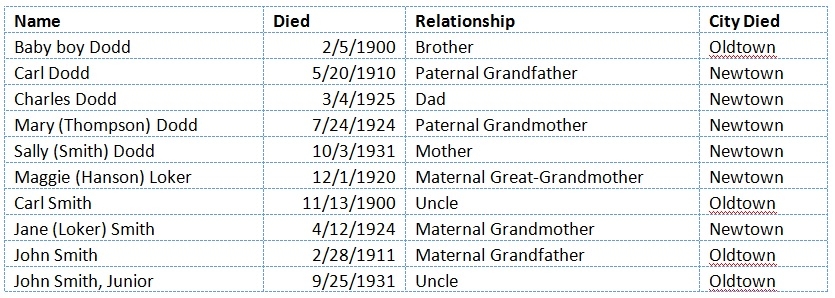
Or maybe it makes sense to you to bring the list in chronological order.
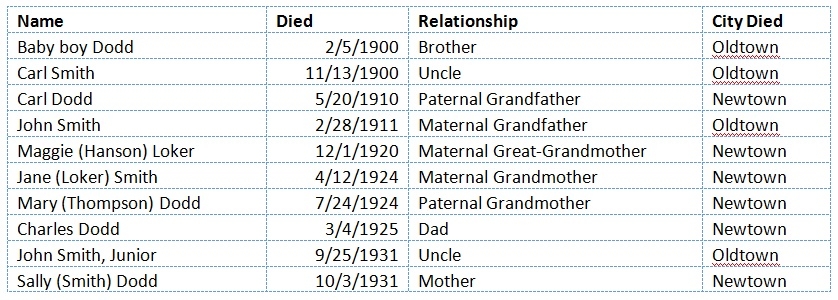
But, your searching will be simplified if you bring the list ordered by location and then date.

Why? Because you are going to find newspapers by the name of the city in which the newspaper was published. The reels of film will span a series of years in chronological order. So, in this scenario, even though the two grandmothers were from different sides of the family, since they both died in the same town in the same year, chances are they will be on the same reel of microfilm. Having your list arranged in this manner will minimize the amount of times you have to load film and wind your way to the correct pages.
The same goes for other types of records. You’ll want to look for all the death certificates in a certain county, in a certain year, at the same time. You’ll want to look for all the naturalization records in a certain county, in a certain year, at the same time. So come with your “things to find” list arranged in the same manner as the microfilm which you will be searching.

Challenging research
If you are looking for something fairly uncommon and/or are not sure where to look, plan to talk to the library staff. They are happy to help. But, before you arrive, make sure you have as much information as possible to share when asking your question. Make sure you know dates, or at least have an approximate date range narrowed down; names, including alternate spellings; and locations.
Things to bring
- Those pencils, mentioned earlier.
- A simple file folder to carry home any copies that you make while you are there. You don’t want the treasures you collected to be creased or crumpled before you arrive home.
- A notebook to take down notes.
- Your list of to-dos and supporting information. A folder, clipboard or small binder will help keep your notes in order.
- Quarters and small bills. You will need small amounts of money for locker rental and copying fees. At the Minnesota History Center, it cost a quarter to rent a locker, but the quarter was refunded when you were done with the locker. Copies cost 35¢ per page in the microfilm room. The biggest expenses for the day were lunch and $6 for parking.
- Eyewear. Make sure to bring your reading glasses or whatever you may need to comfortably look at microfilm readers, books, computer screens and your notes. In my vanity, I wore my contact lenses, but next time, I may just wear my eye glasses so that I can more easily adjust to see whatever I need to see more clearly. It would have been nice able to pull my glasses off at a couple points to squint closely at the fuzzy words on a page.
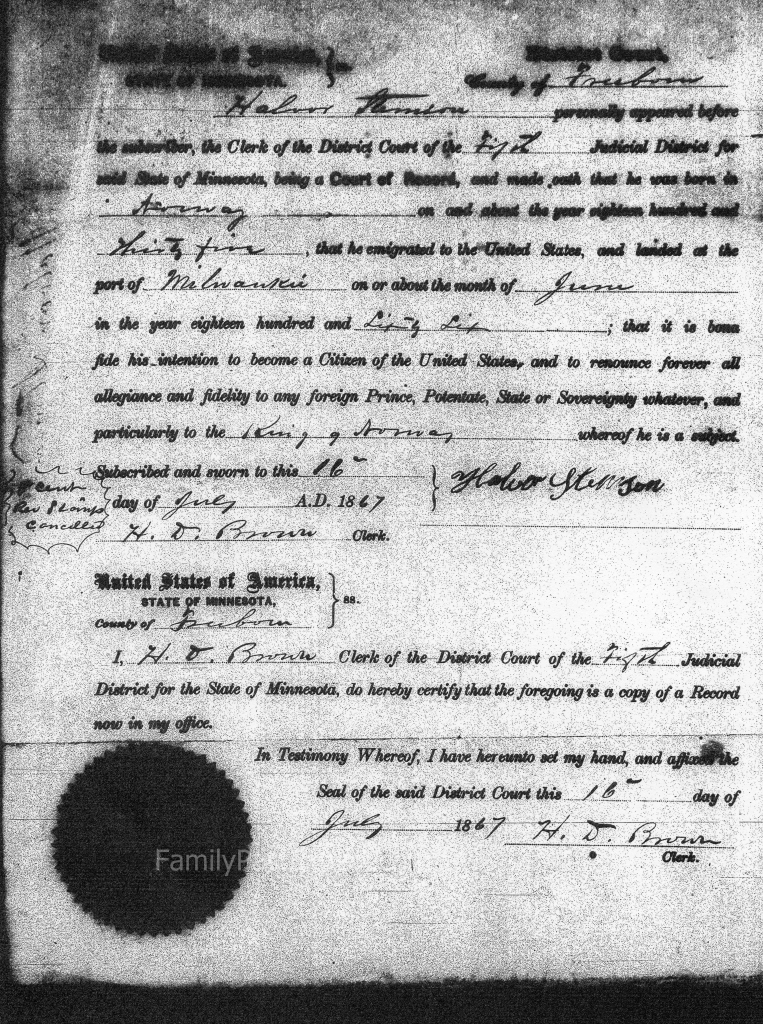
- Patience. Many things at the library are not indexed, so you may find yourself paging through page after page of an old book or microfilm reel trying to find what you are seeking. It is not always an easy process to find what you want when things are not necessarily in alphabetical or even accurate chronological order. So plan to have to work hard sometimes to get results. Also, note that you may have to stand in line to get your turn at things. The biggest bottleneck I found was getting my turn at the microfilm printers.
- A friend. This isn’t a strict requirement, but it is a lot more fun when you have someone to give you encouragement and ideas, and to eat lunch with.
During your visit
Get oriented.
When you arrive, get oriented. Talk to the people at the check in desks if you have questions or to get suggestions. For example, on my recent trip it was recommended to take care of my work in the reading room prior to the microfilm room because it sometimes takes awhile for records to be brought up from storage to the reading room.
Find out the processes you need to follow for retrieving materials. Learn how to use the equipment.

Ask questions
Don’t be afraid to ask for help. The library staff are not necessarily miracle workers, but they may have an idea of a library holding that you hadn’t thought of that might have clues to answer your questions. Or, they may be able to confirm that you are on the right track in your ideas for researching a problem. They can assist you in finding more obscure resources, and due to the nature of their jobs, may have a lot of prior experience that can connect the dots from your question to your answer.
They can also help you with learning to use the equipment, tell you how to get copies made, and even point you to the restroom.
Take notes
While you are in your research frenzy, don’t forget to carefully document where exactly you found anything you found. One easy way is to take a photo of the microfilm box or the holding identifier on other resources. Also, make sure to write down page numbers and other identifying information so that you can appropriately document your source later.
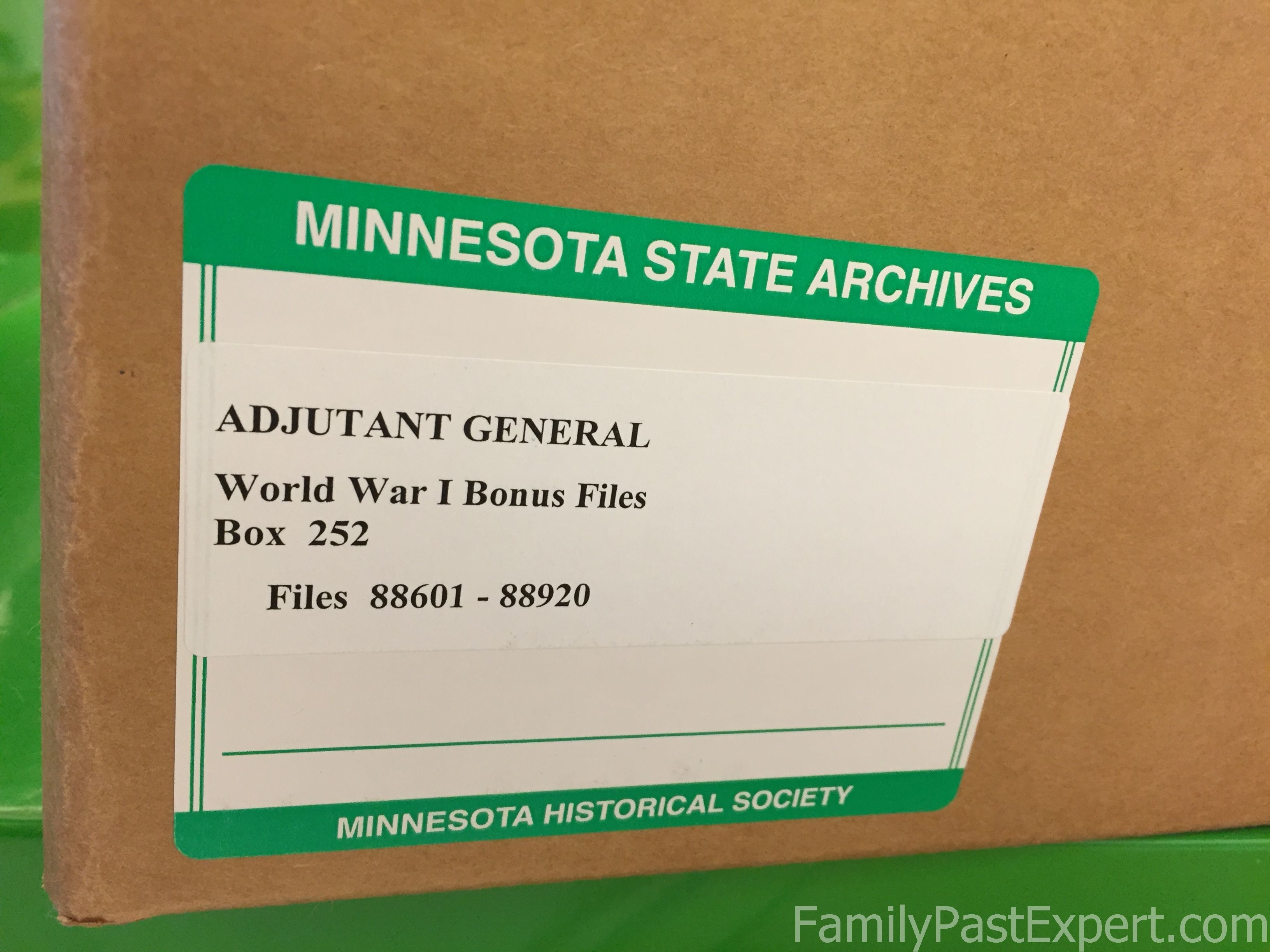
Take a break now and then
Break for lunch or a quick walk. It can be a little overwhelming being surrounded by so much interesting information and after an hour or two of straining your eyes reading microfilm, you need to remember to take a break. Breaks clear your head and may recharge your problem solving skills.
Celebrate your findings
Hopefully, after a day in the library, you will come home with at least a few treasures to add to your genealogy collection. Make sure to take time to organize your work from the day, make sure you’ve tagged any copies of records with their sources, and make sure to file things so you can find them again when you want them. After that it is time to start planning your next trip!

Does this sound like fun?
If spending the day in the library doing research and collecting treasures sounds like fun to you, I encourage you to make time for a trip. Besides getting you out of the house and adding things to your collections, it can open your mind to new ideas on where to find information about your family.
If spending the day in a library doing research sounds extremely boring to you, I can do it for you. Contact FamilyPastExpert.com for your genealogical services needs.
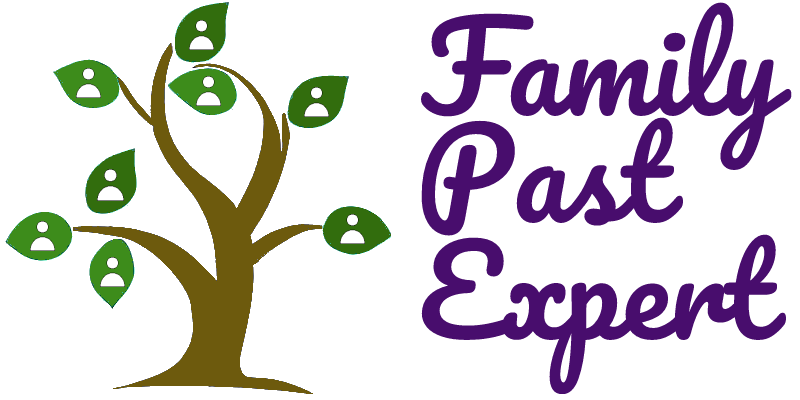

Leave a Reply